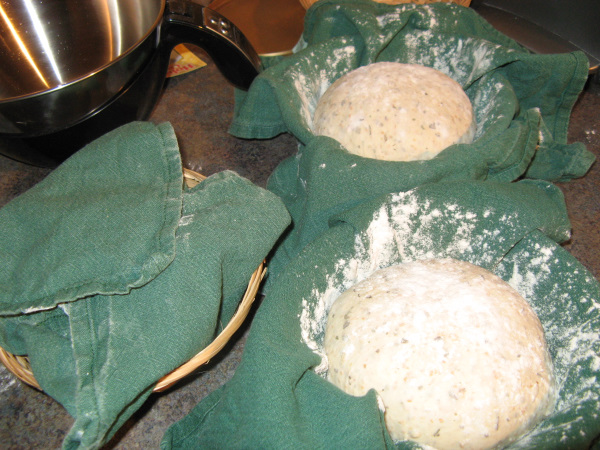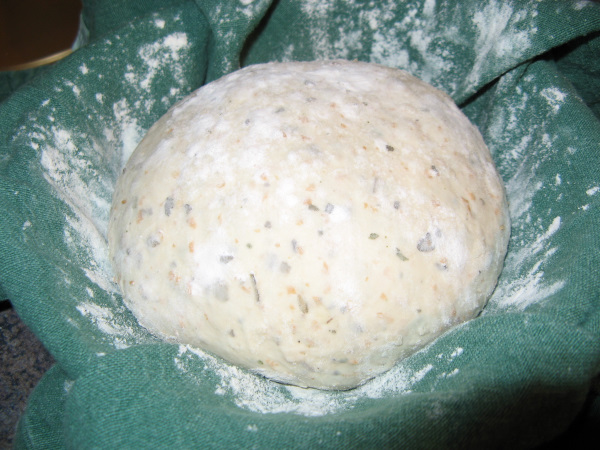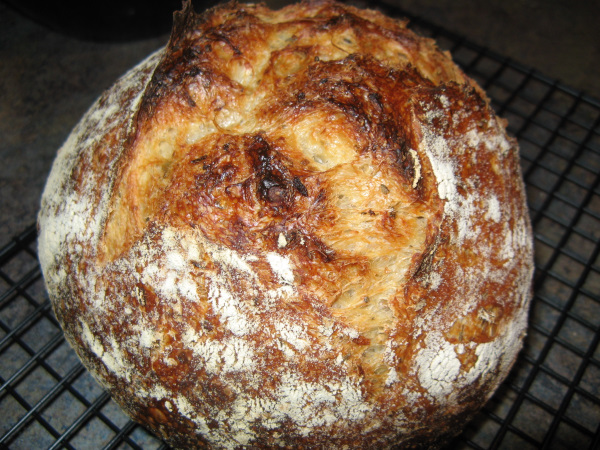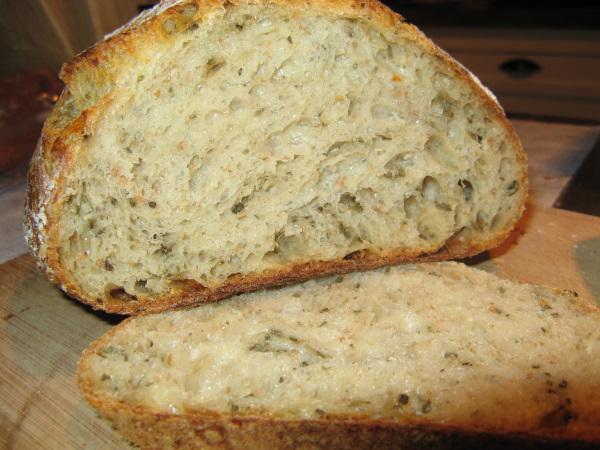
Sage & Onion Levain
This is one of my favourite breads at this time of year. It smells just like stuffing and makes the best leftover turkey sandwiches! It's also great with turkey soup. This is a naturally leavened bread made with fresh, ripe sourdough starter so you can only imagine the smell permeating my kitchen when this bakes - sourdough bread with sage and onions! I usually bake the bread in the Italian bread pans in long loaves, but wanted to see how it turned out baked in the cast iron pots. In a word, it turned out good!

I used 100% hydration bread flour starter, fed and left to ripen overnight. The basic ingredient list is pretty simple:
- 85% bread flour (I use Rogers Silver Star bread flour)
- 15% whole wheat flour
- 70% water (warmed to around 90 degrees)
- 2% sea salt
- 25% starter
Note that the overall hydration is higher than 70% as I just calculate the percentage of starter as a single ingredient, without breaking it down into flour and water percentages. As the starter is 100% hydration this affects the overall dough hydration. It works, at any rate.
The added ingredients are onion and sage. For the onion, I rehydrate dehydrated minced onion in an equal amount of boiling water and let it sit until cool. Use as much as you want (probably around a quarter cup of rehydrated onion per 750 gram loaf). The sage is sometimes chopped fresh sage from my garden, and sometimes rubbed dried sage from the bulk store, depending on the season.
Mix the flours, water and starter well and let sit for 30 minutes or so. Add salt, onion and sage and incorporate well, using whatever method suits you best. I sometimes do this in my stand mixer, and sometimes use Ken Forkish's method (folding and pincering; see https://www.youtube.com/watch?v=HoY7CPw0E1s).
I stretch and fold the dough three or four times over the next couple of hours, and the rest varies depending on what kind of time I have available or what my schedule is. This last batch was fermented at room temperature for about four hours, then in the fridge for another three or four hours. I then shaped it and put it in baskets lined with floured napkins (seam side down as per Ken Forkish). We then went out to see Star Wars and I left the proofing loaves, tucked into plastic bags, in the cool basement. My starter tends to be very vigorous so I didn't want them to overproof.



Once home, I pre-heated the cast iron pots in the oven at 475 degrees, for about 45 minutes. The loaves went into the pots seam side up so I didn't have to score them (they bloom naturally at the seams). 20 minutes with lids on, then another 20 minutes with lids off. The bottom crust was very dark, the top was awesome and the interior temperature was around 205 degrees. They sang as they cooled and I went to bed (late) with the scent of fresh bread filling my head!


This morning I cut a couple of slices to take to work with me, along with a pot of home made turkey soup. Very impressed with the crumb - it was moist, creamy and shiny. I had thought the dough was under-proofed when I put it in the oven, but any more proofing and it would have been a bit too holey for me. All in all, a success!



Comments
I was very excited thinking about your bread! I cut some fresh sage, rosemary and thyme from the yard. I also wanted finely chopped cranberries. To a basic sourdough I made pita. The flavors are great and will match a savory sandwich or a sweet whipped cream/ cream cheese fruit filling.
My usual recipe is 90% hydration on whole grains and 66.6% on white flour. The 2% salt worked well. I also had 50 Gr rye sour. (100% hydration).
The dough has 80% freshly milled white wheat berries and 20% All purpose. All the pita puffed. It is worth giving away.
If you were to do an overnight retard on this bread would you shape first or retard in bulk. Making this to be used for thanksgiving dressing and dtermining overall shcedule including bake day.
Hi lazy loafer! This looks tooooo good. Would just like to clarify one thing in your method before I attempt this. Do you put the dough in the fridge before shaping? The method I think I’m seeing is after your folds, you put in the fridge, then take out the fridge to shape, then bake? Do you need to proof again after the final shaping? Thank you! Can’t wait to make these
Pages